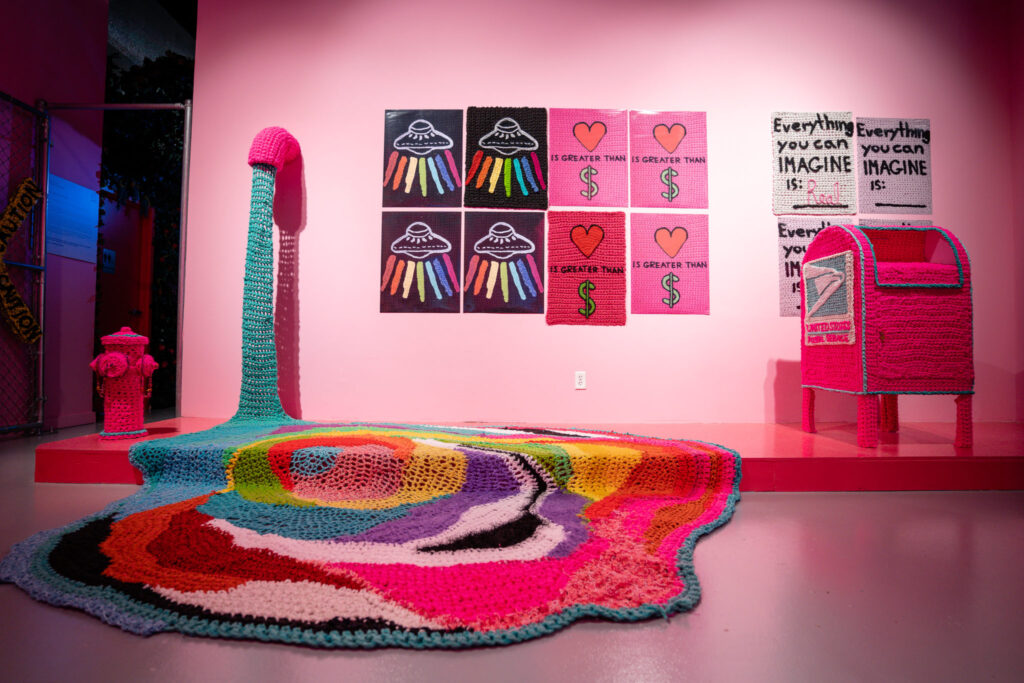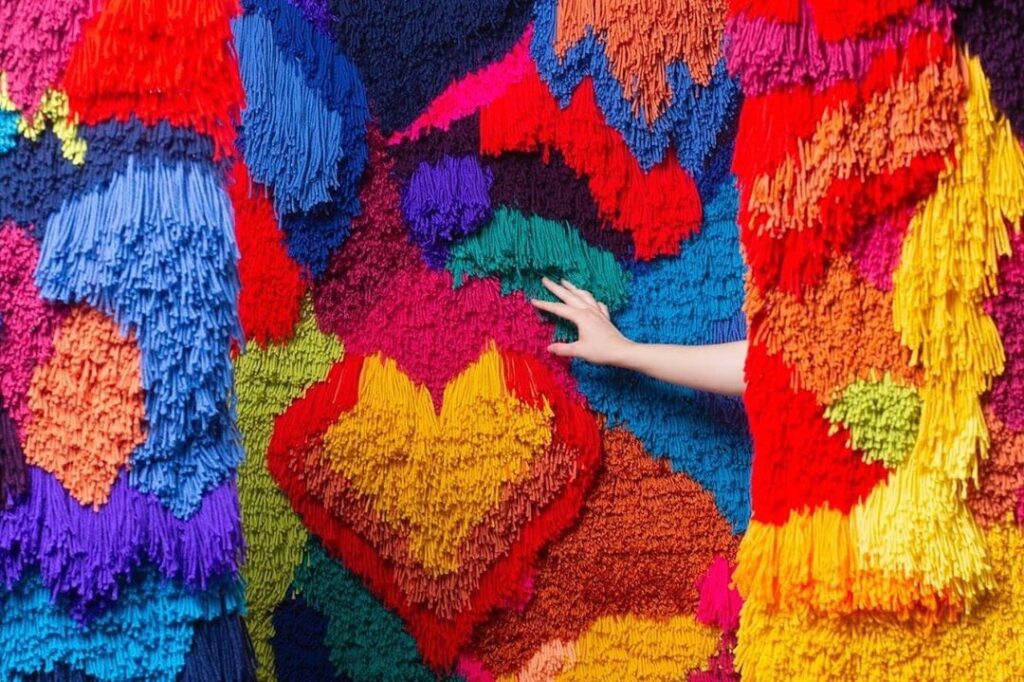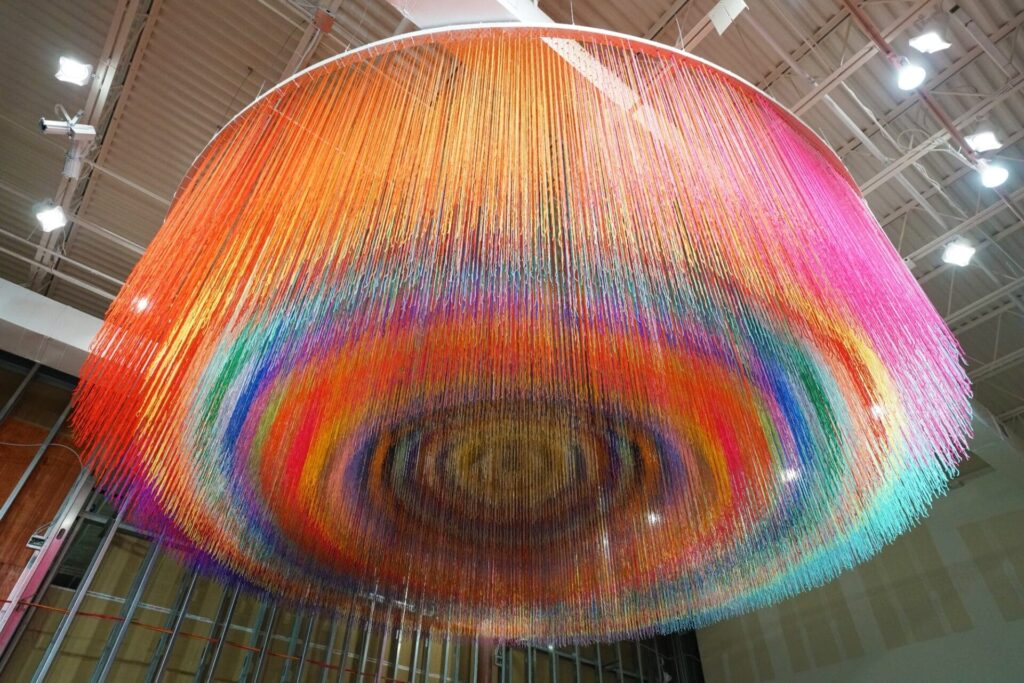In the world of hospitality, creating a memorable and immersive experience for guests is paramount. Beyond comfortable accommodations and excellent service, hotels are increasingly turning to art to elevate the guest experience.
One form of art that has gained popularity in recent years is hotel yarn art. This is a unique and captivating medium that transforms spaces into vibrant works of art.
Because of its natural resilience and tactile nature, yarn art is the perfect form of immersive art to entice thousands of visitors a year.

Origins of Yarn Art
Yarn art, also known as yarn bombing or yarn graffiti, has its roots in the street art movement of the early 2000s. Originating as a form of guerrilla artwork, yarn bombing involves covering public objects or structures with colorful knitted or crocheted yarn.
Similar to graffiti, yarn bombing has evolved from a subversive act of creativity into a legitimate art form. Artists around the world use yarn to transform urban landscapes and create community-driven art installations.
Local knitting communities have begun organizing to set up exhibits that display their extensive works of yarn art. This introduces their communities to new mediums of art and drawing new artists to the field.
The Evolution of Hotel Yarn Art
As the popularity of yarn art has grown, artists have begun exploring new ways to incorporate the medium into different environments. Hotels, with their diverse spaces and captive audiences, are ideal canvases for yarn artists to showcase their talents.
From lobbies and corridors to guest rooms and outdoor spaces, hotel yarn art has the potential to transform any area into an entrancing, immersive environment. It can entertain thousands of people who are actively looking for new experiences.
Techniques and Process
The process of creating hotel yarn art is as varied and creative as the artists themselves.
Some artists use traditional knitting or crocheting techniques to create intricate patterns and designs. Others employ more unconventional methods such as weaving, braiding, or knotting.
The choice of materials – from natural fibers like wool and cotton to synthetic yarns and recycled materials – adds another layer of texture and visual interest to the finished artwork.
One of the unique aspects of hotel yarn art is its adaptability to different spaces and architectural features. Artists can tailor their designs to complement the aesthetic of the hotel, whether it be a sleek, modern interior or a historic building rich in character and charm.
From large-scale installations that cover entire walls to smaller, more intimate pieces that adorn furniture or fixtures, hotel yarn art can transform any space into a one-of-a-kind work of art.
Impact on Guests and Spaces
The presence of hotel yarn art can have a profound impact on both guests and spaces. For guests, encountering yarn art in a hotel setting can evoke feelings of wonder, delight, and surprise.
Whether it’s stumbling upon a colorful installation in a hallway or admiring a meticulously crafted piece in a guest room, yarn art adds an element of whimsy and personality to the guest experience.
From a design perspective, hotel yarn art has the power to transform ordinary spaces into extraordinary works of art. By adding texture, color, and dimension to walls, ceilings, and other surfaces, yarn art can enhance the overall ambiance of a hotel, creating a sense of warmth, comfort, and welcome for guests.
Alternatively, thematic exhibits can lead guests to reflect on the message of the art in an immersive environment.

Examples of Hotel Yarn Art
Numerous hotels around the world have embraced art as a means of enhancing their guest experience and creating memorable, Instagram-worthy moments.
Hotels such as 21c offer hotel rooms in buildings filled with local art and multiple exhibits. Some of which are only available to guests.
Large hotel chains such as Hyatt have begun creating locations that are art-centered to serve travelers with more artistic tastes. From boutique hotels to luxury resorts, yarn art has found its way into a variety of settings, each one showcasing the creativity and ingenuity of the artists involved.
One of the most famous examples is the Sweet Tooth Hotel in Dallas, Texas. The building that the Sweet Tooth Hotel exists in is a hotel, but functionally the business is a museum.
There are multiple exhibits and guests cannot stay the night. Visitors instead make their way through the lobby and visit hotel “rooms” which are set up as large, immersive art exhibits.
The museum invites several fabric artists every few years to create new, thematic exhibits that fully cover each room.
Another notable example is the 21c Museum Hotel in Louisville, Kentucky, which features a stunning installation titled “Knit Knot” by artist HOTTEA.
Consisting of thousands of strands of colorful yarn suspended from the ceiling, the installation creates an immersive, interactive environment that invites guests to engage with the artwork on a tactile and sensory level.

Some museums allow guests to interact with the art, touching and feeling the yarn to truly grasp the full tactile experience and appreciate the difficulty of producing it. However, factors such as the COVID-19 pandemic and wear-and-tear on the exhibits has led many exhibits to restrict guests from touching the art.
Conclusion
In a world where first impressions are everything, hotels are constantly seeking new ways to create memorable and immersive experiences for their guests.
Hotel yarn art offers a unique and creative solution. It transforms ordinary spaces into extraordinary works of art that captivate the imagination and delight the senses.
As the popularity of hotel yarn art continues to grow, we can expect to see more hotels embracing this innovative medium as a means of enhancing their guest experience and creating lasting memories for years to come.
References
Correa, Crystal. “Inside Dallas’ Sweet Tooth Hotel — How an Immersive Art Wonderland is Adapting and Changing.” Paper City, April 19, 2021. https://www.papercitymag.com/arts/sweet-tooth-hotel-dallas-victory-park-immersive-art/.
Gifford, Erin. “20 Best Art Hotels in America. HGTV, April 23, 2021. https://www.hgtv.com/lifestyle/travel/best-art-hotels-in-america-pictures.